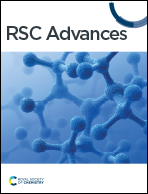Decoration of polystyrene with nanoparticles of cobalt hydroxide as new composites for the removal of Fe(iii) and methylene blue from industrial wastewater
Abstract
Effluent water from different industries is considered one of the most serious environmental pollutants due to its non-safe disposal. Therefore, proper treatment methods for such wastewater are strongly stimulated for its potential reuse in industries or agriculture. This study introduces a composite fabricated via doping of polystyrene with nanoparticles of cobalt hydroxide as a novel adsorbent for dye and heavy metal decontamination from wastewater. The adsorbent fabrication involves the preparation of polystyrene via high-internal phase emulation (HIPE) polymerization followed by its intercalation with particles of alkali cobalt. The chemical composition and structural properties of the synthesized composite were confirmed by X-ray diffraction (XRD), Fourier transform infrared (FTIR) spectroscopy, and energy-dispersive X-ray spectroscopy (EDX). Moreover, scanning electron microscopy (SEM) and N2 adsorption–desorption surface area analysis were performed to identify the surface and morphological characteristics of the composite. Then, the ability of this structure toward the removal of methylene blue dye (MB) and heavy metal (iron III) species from waste aqueous solutions was investigated. Successful elimination for both MB and Fe(III) was achieved by the presented composite. Elevated adsorption capacities of 75.2 and 112.3 mg g−1, toward MB and Fe(III) respectively, were detected for the presented polymer-metal hydroxide composite. The increased values of the composite are attributed to the presence of both organic and inorganic functional groups within its structure. Kinetic and isotherm studies for the removal of both cationic species revealed that adsorption processes fit the pseudo-second-order kinetic model and Langmuir isotherm model. Additionally, thermodynamics measurements indicated that the adsorption process of methylene blue and Fe ions is feasible, spontaneous, physisorption, and endothermic.



 Please wait while we load your content...
Please wait while we load your content...